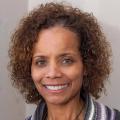Young people ignited by injustice, refusing to back down. A nation waking up to the reality of racial disparities. And a church that can no longer remain silent. This, says Eden Theological Seminary professor Leah Francis Gunning, is the real “Ferguson Effect.” As she protested in Ferguson over the past year, Gunning collected interviews from clergy and young organizers. The result is Ferguson and Faith: Sparking Leadership & Awakening Community (Chalice Press, 2015), a behind-the-scenes look at the role of the church in the Black Lives Matter movement. Sojourners interviewed Francis to learn more about the religious community’s role in supporting and sustaining a racial justice movement started by young activists.
Sojourners: In Ferguson and Faith, you describe the evening you first learned about the killing of Mike Brown: “I was convinced that life in St. Louis would never be the same.” How did you know his death would have such a big impact?
Leah Gunning Francis: To see the image of Mike Brown’s body on TV and social media, with the blood pouring down the middle of the street, I just felt internally that this is a game changer in terms of really opening the eyes of everybody to the reality that so many young black people have been facing for decades. I knew there was no way we could pretend that we didn’t see this, and that it was just another unfortunate accident.
How has the Black Lives Matter movement changed your theology?
My theology has been strengthened and affirmed by the Black Lives Matter movement. I always knew that God was a God of the oppressed, as James Cone says, and that God does stand on the side of love, but [with this movement], I saw that theology lived out. I was well-informed in Liberation theology and Womanist theology and Black theology in seminary and in my work, but to actually be able to live into it has been transforming for me personally.
What role should the church play in current racial justice movements?
In my observation there are congregations that are taking seriously their roles in seeking to be agents of change in the movements for racial justice, but the church writ-large, is not. At some point we need to move beyond statements and posture to actually engaging in these matters in life-transforming ways. One good first step toward this is to open the constructive conversation about race in congregations.
What church did racial justice well this year?
Compton Heights Christian Church is a modest size Disciples of Christ church in St. Louis. Maybe 25 percent of the church are people of color. In the past, they have been involved in outreach activities but not a lot tailored toward racial justice. When Ferguson happened, their pastor got involved in protests, and when she invited the congregation to participate with her, they did so. And here’s how: They reimagined what it means to be a safe sanctuary. Often times we think of safe sanctuaries as places where children won’t be harmed and people are appropriately trained. That’s important. But they’ve expanded this definition of safe sanctuary to really think about what it means to welcome those who don’t feel welcome. In the movement, they opened their sanctuary doors as places of training, gathering, cooking — and equally important — as places of prayer. One of the young activists came to the pastor and said, “Why are your doors opened to us?” Because so many doors had been closed — not just to the protesters, but to young people generally who don’t often feel welcome in our congregations because of who they choose to love or how they choose to wear their clothes.
Is there a specific action that was particularly inspiring to you?
I was privileged to help coordinate the Mother’s March with three other clergy. The four of us are mothers and we know that in the midst of all of this there are other mothers who want to stand up on behalf of all of our children. And so we wanted to lament the lives of the children who have been lost violently and to stand together to bring an end to police brutality. At the end of the march we released balloons in acknowledgement of all the lives that had been lost violently in St. Louis that past year. So we released 90 balloons to send off our signal that they’re not forgotten and we are working on their behalf.
In the last chapter of your book you write, “The goal is not just to be able to say, ‘I have black friends,’ but to genuinely seek to be in relationship with people who are racially different in an attempt to move beyond stereotypes and build authentic community.” How do we do that?
I am a professor at Eden Seminary and a few years ago I had a student say to me, “Professor Francis you are my first black teacher.” And that hit me like a ton of bricks because that was a graduate class. There are tons of people who have no meaningful interaction with people of color. First we need our white brothers and sisters to do a self-survey: What has been your interaction with African Americans? Not just seeing someone in the store, but what’s been your interaction? Once you take stock of that, you can have good conversation within communities about how we can foster more genuine peer relationships.
In what ways can faith prevent desensitization or disillusionment in the movement?
The role of faith communities is to keep the heat on, if you will. We have to continue to be the voice that names this as an injustice against humanity and a crime against God. Because there are so many [black deaths] we can’t just allow names to become hashtags and then just go back to business as usual until the next time.
Got something to say about what you're reading? We value your feedback!


